Optical Illusion Cake Tutorial
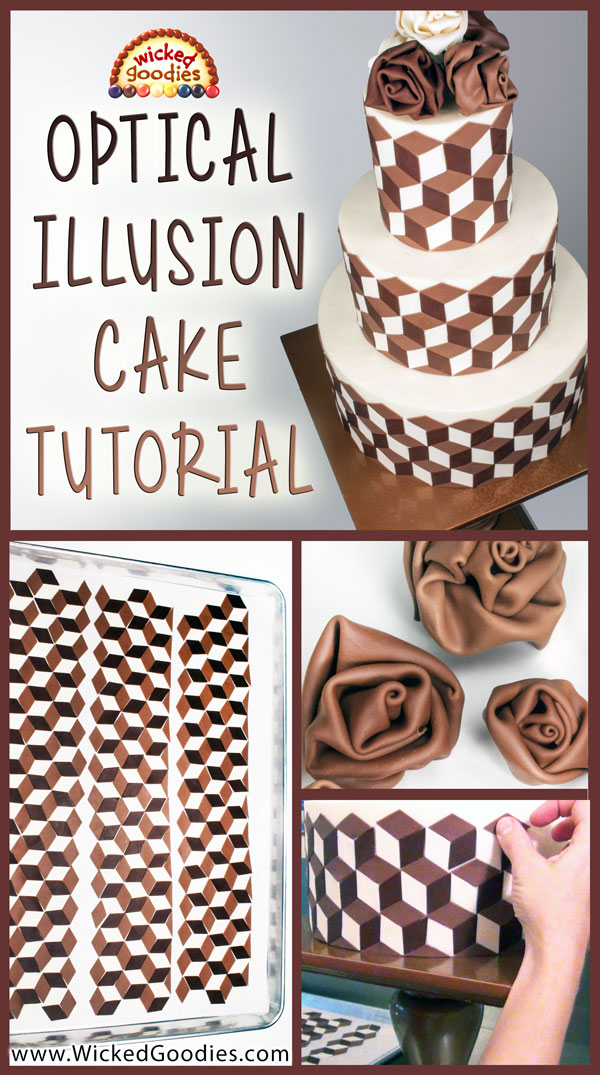
This tutorial demonstrates how to make an optical illusion cake using three different tones of rolled modeling chocolate. This is a 2-dimensional design that gives the impression of 3-dimensional cubes.
VIDEO: Optical Illusion Cake
Below is a photo transcript of the video with links and additional tips. Here are my recipes for modeling chocolate and videos on how to roll modeling chocolate. This round wedding cake was frosted with smooth vanilla buttercream.
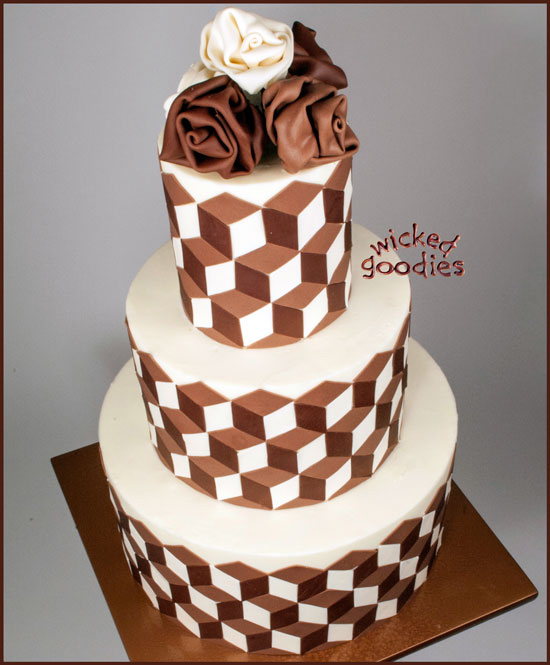
To start, you need white modeling chocolate, dark modeling chocolate and a combination of the two. The lighter chocolate color can be made by kneading half and half dark and white modeling chocolate together.
Sample the book
Cake Decorating with Modeling Chocolate
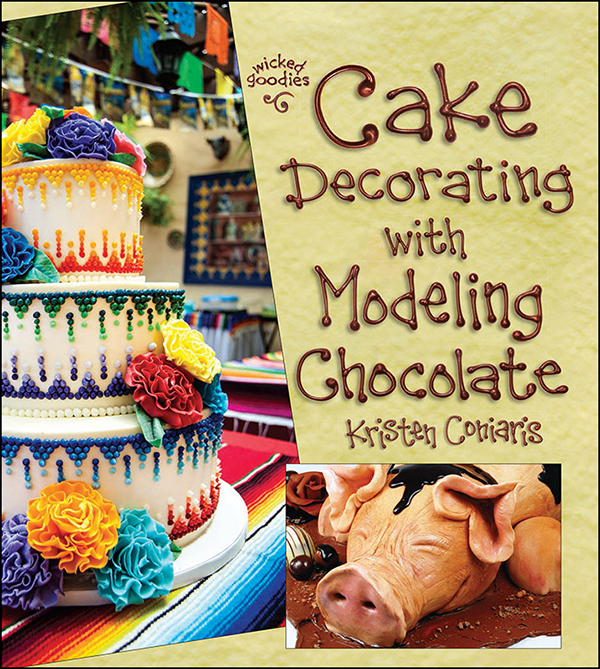
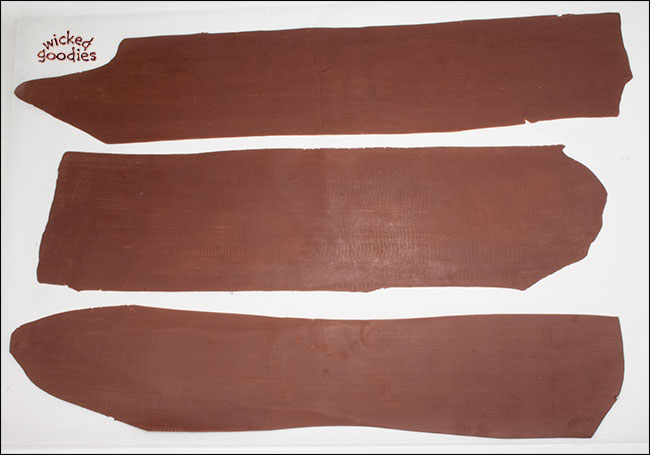
Begin by rolling out the modeling chocolate into thin sheets.
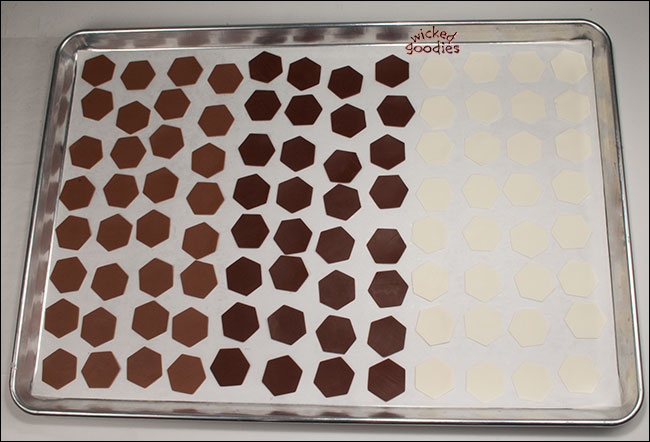
Using a 2″ diameter or 51 millimeter (measured tip to tip, which) hexagon cutter, begin by cutting the same shape out of all three colors of rolled modeling chocolate.
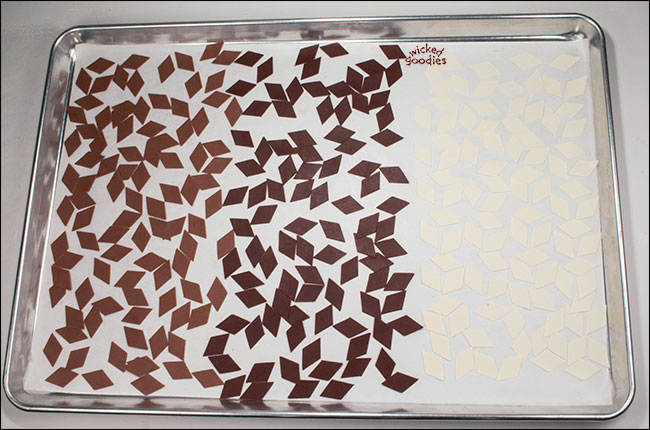
Then cut each hexagon into three pieces to make three equal sized diamonds. If you happen to have a diamond cutter that works for this design, go ahead and use it. The problem is that most diamond cutters aren’t quite the right shape to make it work.

However the hexagon cutter works well. The trick is to use the opposite point as a guide (see video above). Align the first two cuts in the direction of their opposite points. Then cut the remaining V-shape in half. That way, the diamonds should come out the same.
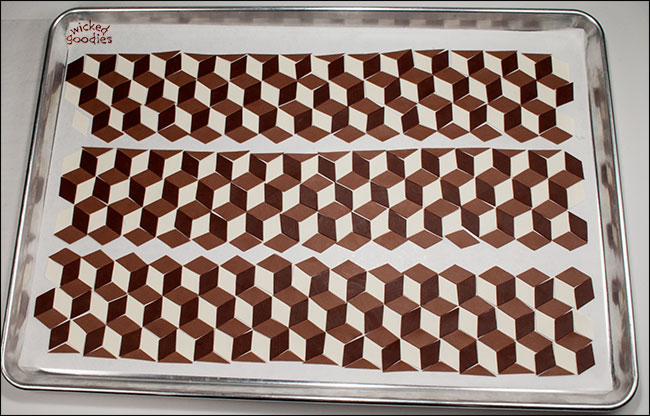
Ready the pieces on a sheet pan so that they are all lined up with each hexagon containing all three colors.
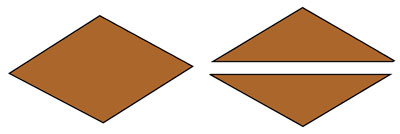
Some of the triangles of one color will need to be cut once more the long way down the middle to create bottom pieces.
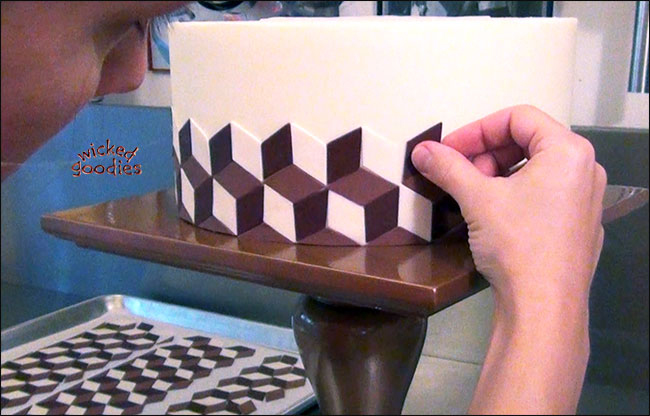
Once the cake is frosted with buttercream and chilled, begin assembling the design, working with the bottom pieces from the bottom of the cake up. The first row is medium chocolate bottom pieces. The second row is a dark and white chocolate zig zag. The third row is sideways medium chocolate diamonds. The fourth row is dark and white chocolate zig zag except the position of the colors is reversed. The fifth row is another layer of sideways medium chocolate diamonds. And so on and so forth.
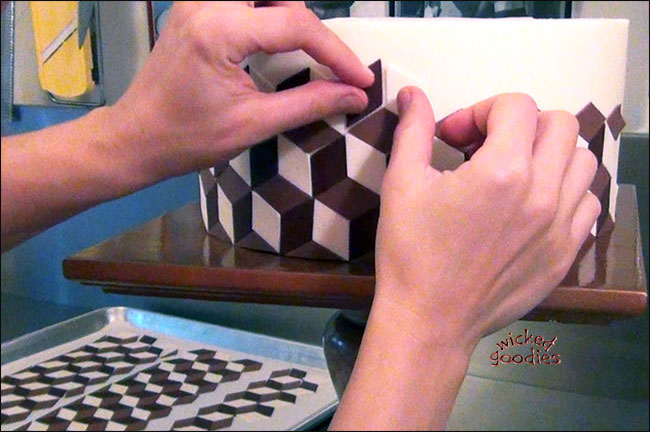
You can adjust the position of the modeling chocolate diamonds by sliding them around on the cold buttercream frosting.
As an alternative to placing the pieces directly onto the cake one by one, you can also pre-arrange the pieces on strips of acetate then press them onto the sides of cake and peel away the acetate gently, kind of like a press-on tattoo. Modeling chocolate loosely sticks to acetate without any adhesive so it makes the perfect transferring medium. Once the pieces are on the cake, if they need to be shifted or re-arranged at all, do it right away before they bond with the cold buttercream frosting.
Follow this link to see my video tutorial on how to make easy modeling chocolate roses.
Here is the final product:
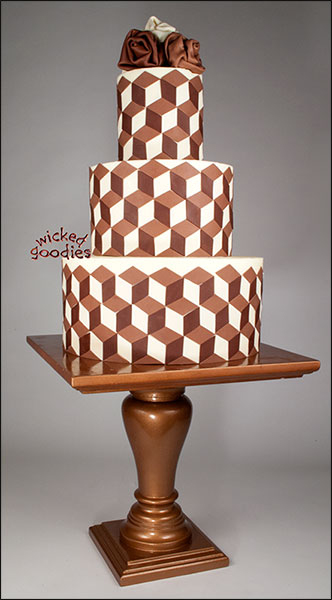
Cake stand made by Shannon of Batter Up Cake Co.
I invite you to share a photo of your work below in the comment section so that others can find inspiration in your own unique interpretations. If you run a cake business, be sure to tag it.
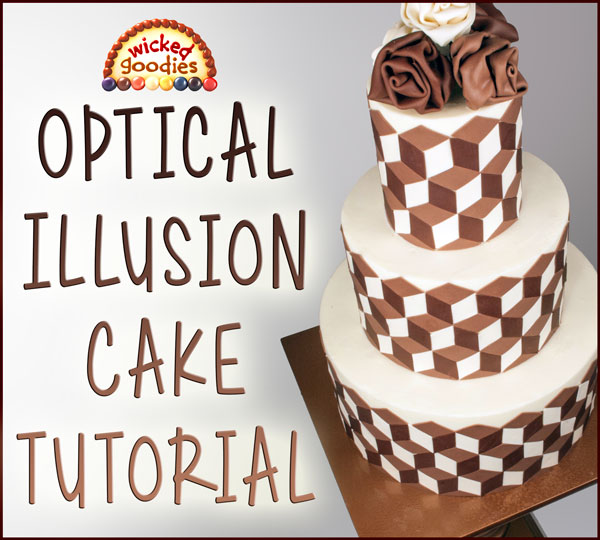
Get my recipes and technique for crisp frosting here:
Smooth Buttercream Cake Frosting
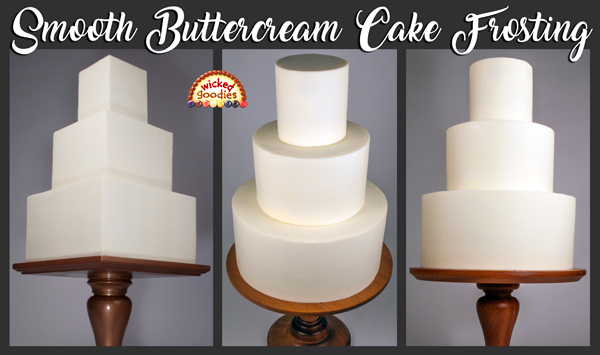 You might also enjoy
You might also enjoy
Modeling Chocolate Leopard Print Tutorial
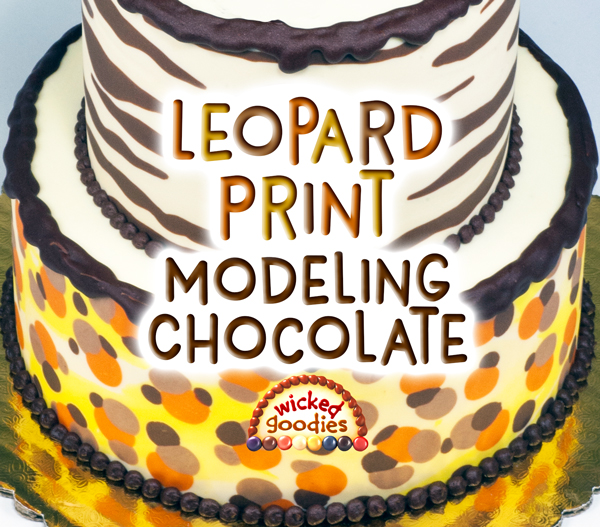
Modeling Chocolate Lace Garter Belt Tutorial
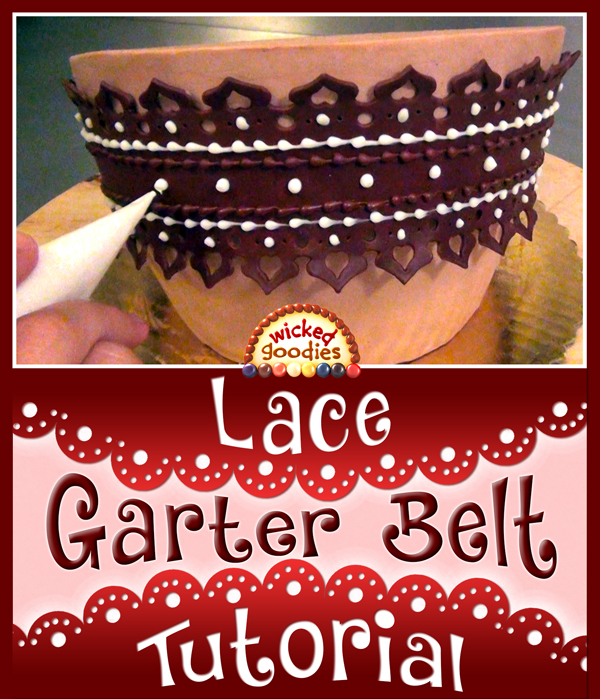
How to Marble Modeling Chocolate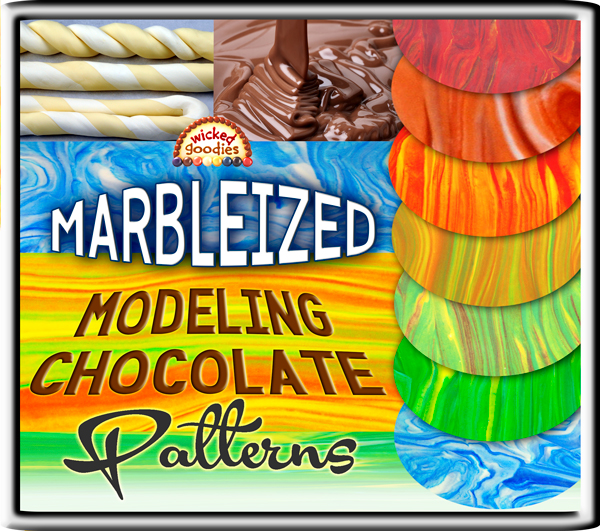
3D Pig Cake Tutorial
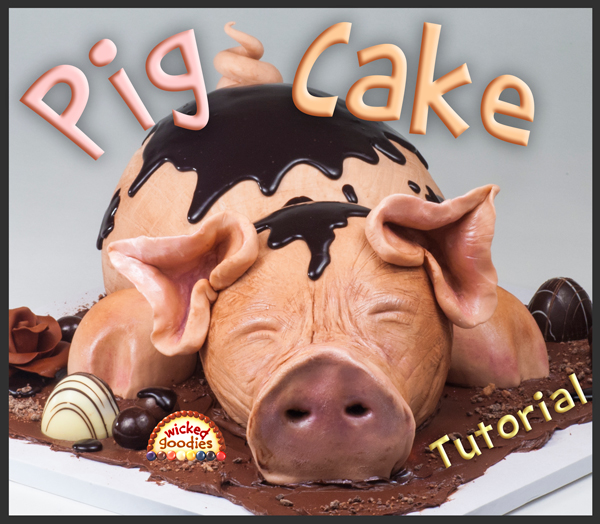
3D Car Cake Sculpting Tricks
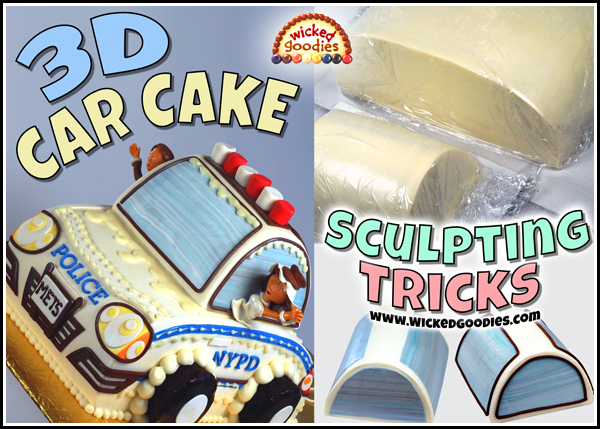
Modeling Chocolate Resource Guide

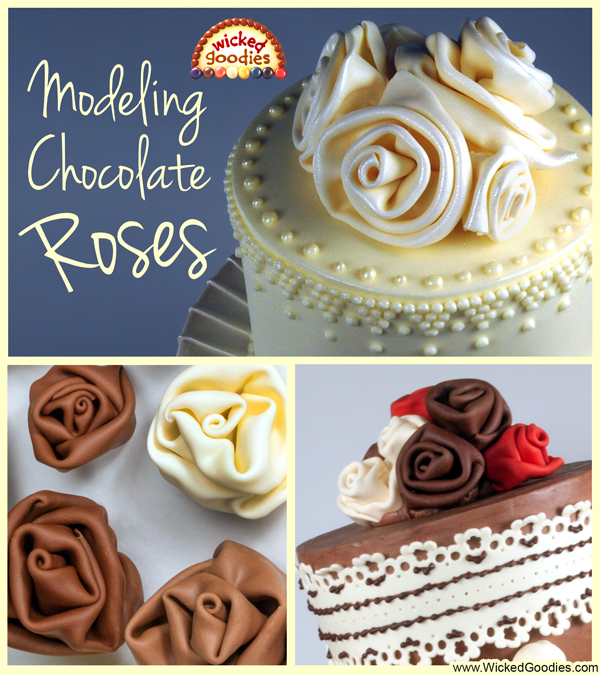



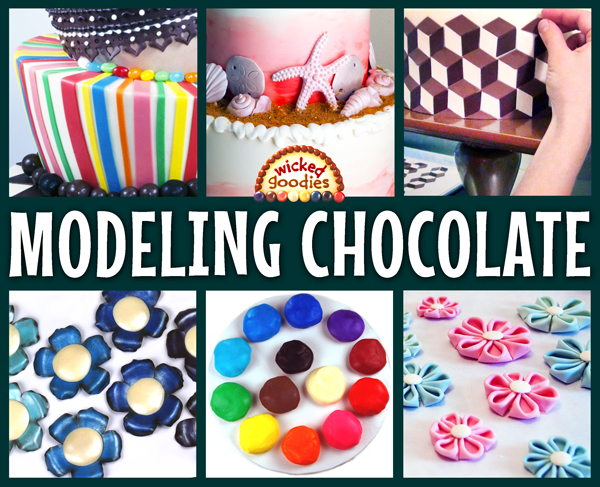
hi i was wondering how to i count the size of the hexacon so i dont get overlap or that it doesn’t close great cake love it also the modeling chocolate amazing to work with
Looks great! My preference over trying to get decorations like this to meet perfectly (which is nearly impossible if you are working with a multi-tier cake since each tier then has a different circumference) is to bring the pieces to the point of overlap then slice through them using a craft utility knife, making a straight vertical line. Peel away the excess so the design zips together flush. There will be a seam there where the pattern appears disrupted. Pipe a vertical row of buttercream dots right on top of that seam. Make a continuous row of small pearl-like dots as you would pipe around the base of a cake. It will look like a row of buttons, as per the back of a dress. In fact it will look as if it’s meant to be there. In my opinion, this is the best way to deal with design seams on cakes.
If the cake is to be displayed against a wall, I wouldn’t bother with this level of detail. Then I would simply turn the seams to face the wall, where nobody can see them. Only in the case when a cake is to be displayed in the center of a room do I bother dressing up the seams, because then people can see them.
thanks for your quick response and tips
thus cake I wanted to make already long time and it turned out great thank you again
Bellisimo pastel
Bellissimo,il diametro della torta di quanto dovrebbe essere usando l’esagono di 2 cm?Grazie
Si – quello che è 50,8 millimetri da punto a punto.
I am planning to make this cake soon and I’m wondering if I can do it with two tone chocolate, do I get the same results as yours for optical illusion? thanks.
No – it must be three tone to get the effect.
You are the best
Great
I’m grateful for this
Excellent idea and beautiful work. Thank you
Wow! brilliant! I am from Tonga and we don’t have supplies here but I will definitely try and get the right tools and make this cake. Very inspiring and I know it will take a while for me to get the right tools but the time will definitely come. Will post it when that time comes. Thank you for this awesome technique.
Excellent program
Beautifuly explained
Loved your idea.:-)
Thanks for sharing.
Did it for my husbands birthday , but with sugar paste
Excellent job! Thanks for the share!
thanks so much for the tutorial!
Wow! That cake is so elaborate! Amazing!
I couldn’t wait to try this cake! So excited! Thank you for the tutorial, it lead me every step of the way. I did change it by using all fondant instead of chocolate…
That looks fabulous! Thank you for sharing a photo, LeeAnne! It’s cool to see an example using fondant 🙂
Had the thought of usING blue before I saw this so cool love it 🙂
es una tecnica muy originas, ya me voy a poner a practicarla, excelente
Another beautiful version made by Annabel at Conjurer’s Kitchen http://www.conjurerskitchen.com/
That’s awesome. How long did it take
Hmm…not sure. I didn’t time it and I was filming the whole time so that slowed the whole process down a bit! On the first day, I rolled out the modeling chocolate and cut it into shapes. On the second day, I used them to decorate the cake. It was definitely more tedious than your average cake but well worth it!
Made by Pauline of Bite Me Bakery http://bmbakery.blogspot.com/
Great job, Pauline!
Thanks so much for showing off my cake! Your tutorial was beyond helpful!!
amazing design.
can i use a diamond shape cutter for this design?
thks
If you happen to have a diamond cutter that works for this design, go ahead and use it. The problem is that most diamond cutters aren’t quite the right shape to fit together into a hexagon. If I were you, I would test our your diamond cutter to see if it works. If not, use a hexagon cutter then cut its shape into three equal-sized diamonds with a knife.
Thank you so much for your tutorial! I made my father-in-law’s 70th birthday cake using your tutorial. I didn’t leave myself enough time, so its not brilliant, but it gave the illusion effect and everyone was impressed. Thank you 🙂
That’s beautiful , can’t wait to try it ..
Fantastic! Great job, Michelle. Your father-in-law must have been thrilled. Thank you for sharing your wonderful results 🙂
I’m just amazed by all these beautiful cakes … May I ask what size cutter you used???
Thank you
Stella
I used a 1.5″ diameter hexagon cutter.
thank you………….
hermosassss me encantan!!!!
Can you help me with a few things. Example, website and this tutorial
I am so glad to have found your site and blog, I love working with chocolate and your instructions are simple and clear, cant wait to try
That’s incredible…can’t wait to try it! What did you do to make sure the pattern “fit” properly around the circumference? (e.g. what happens if the spacing doesn’t work out, and the last pieces don’t meet up with the first ones)? Did you measure it all out using your cutter first? Or did you adjust the spacing once you had completed the base row?
That’s a good question. Thank you for asking as I’m sure other readers are wondering the same thing. No, I didn’t measure, I just winged it…but I did make sure to use a round cake since this design is more difficult to do on a square. On round cakes, ultimately, there is always a seam at the start/stop location where the pattern meets. I call this the “back” of the cake and I turn that part out of sight so that no one can see it (provided the cake is displayed against a wall). If the cake is to be displayed in the center of a room, I would complete the pattern as best as possible then pipe a row of buttercream dots down the seam to cover it up. That gives cakes the intentional look of a zipper or row of buttons, as if the pattern is made of fabric and that’s where it was closed up. Alternatively, you could cover up that seam with some more chocolate flowers or another decoration of some sort. The key is to make it look natural, as if you meant for that decoration or row of dots to be there all along.
It is possible on a square cake, as long as you have the right size cutters. I do find it easier to make it fit by not adding the white parts.
Forgot the picture 🙂
That’s a gorgeous cake! Thanks for sharing! It’s interesting to see your different technique.
hekiiieeh
Thank you so much for sharing.you are an amazing.can you tell me how many inches tall this cakes
Each tier of my cake was about 4″ tall so the cake was about 12″ tall in total.
Very impressive. Is it ok to try the technique? Can you do it with different coloured fondants? Thanks heaps. Very inspirational.
YES AND YES. Good luck and have fun!
Thank you so much for sharing.
You are very welcome!
Awesome tutorial – question you put the chocolate on frosting not fondant? thank you
On frosting. It’s a buttercream-frosted cake.
Thank you
Thank you, you are an amazing talent and very generous for sharing your knowledge with us.
My pleasure!
Thank you so much for sharing. I made a cake a couple of months back that had one side with this pattern, and oh boy, was that difficult! I can’t wait to use your technique! Thanks again!
Here is the cake!
Holy cow! That’s super cool! You got more than one illusion on there too I see. Wow great job. Thanks for sharing 🙂
How do you determine the amount of modeling chocolate to make when you are creating projects like this? I know it’s better to have too much than not enough, but what’s the best way to determine that?
You are so talented and very considerate for sharing your great ideas and tutorials!
Thanks!
You are very welcome. How much modeling chocolate you need depends entirely on how thinly you roll it. If you lay it on thickly like fondant, a batch will be gone in no time. If you roll it quite thinly, it will last much longer. It takes practice to learn how to roll it that thinly though. So for that 3-tiered 6″ 8″ 10″ cake, I started with two batches of dark modeling chocolate and two batches of white modeling chocolate. I had a lot left over in the end, which was my intention all along. I prefer to have extra rather than risk not having enough.
OMG…I thought this was computer generated on a transfer sheet! I have to do it. Thank you Kristen for sharing this witus.
Shannon, I hope you notice that I took your advice and narrated the video 🙂
So very awesome. I can’t wait to try this optical illusion technique. Thanks very much for sharing.